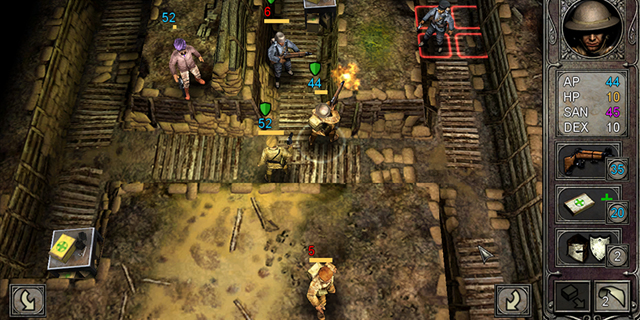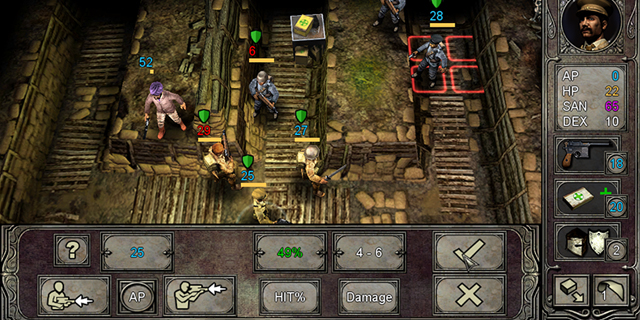
The trenches of World War I are not a familiar battleground for any gamers, as most games tend to focus on the Second World War. However, that’s exactly where you’ll find yourself in The Wasted Land. These trenches aren’t populated merely with Germans though, but also the horrors of the Cthulhu mythos. Your squad is the last hope for saving humanity.
The Wasted Land is based on the Call of Cthulhu short story by H. P. Lovecraft, and the story is fittingly horrific for the subject material. The Cult of the Awakened is trying to bring back Cthulhu and, through a series of missions, you are to prevent this from happening.
As a turn-based strategy game, The Wasted Land has pretty much all the basics you’d expect. Each unit has a set amount of action points per turn, which can be used to move around, shoot, heal, use magic or stab. You can use them however you want, but each action has a certain cost, and thus can only do so much each turn. Attacks also have a powered up version with makes them more accurate, but at a cost of using more action points. This is an important thing to remember, due to how inaccurate most attacks are at their basic level. In fact, even when an enemy is immediately in front of you, you’re just as likely to miss as hit them, without using the more powerful version.
There are many types of enemies you’ll face, from German soldiers to Cultists to Cthulhu monstrosities. Each time you attack or get attacked by a Cthulhu creature, you’ll lose a little bit of Sanity, a second meter aside from Health that measures your mental health. It’s important to keep track of your sanity because when you run out of it, one of two things will happen: either you will be paralyzed for a few turns or you will get ‘manic’ and gain a large amount of action points for a few turns before dying until the end of the mission. Timed well, this can be the difference between winning the mission or losing and having to try again.
As much as the gameplay and story are largely positive, the interface and control scheme do nothing but harm it. The interface is very counterintuitive, yet has very little to help you figure out what each button, abbreviation or unfamiliar word is. It took me five missions to even realize that two images in the attack menu were even buttons used to change which type of attack I was doing. When selecting categories to spend experience points on between missions, it’s even worse because there are over a dozen categories and no explanation of what each one does. I’m certain the handgun category relates to handguns in some way, but does it improve accuracy? Damage? Critical chance? Some combination thereof? I have no idea, and no way to find out. It’s worse for categories like ‘Cthulhu Mythology,’ which are so generic that it could mean almost anything.

Controlling your units is, for the most part, simple and easy, a relic of its previous incarnation as an iOS game. However, all unit commands rely on the same left mouse click. Want to look at an enemy’s stats? Click on him. Want to attack it? Click and hold on him. This works okay when your unit and the target are on the screen together, but for more distance attacks, it is maddeningly frustrating to get it to recognize what you want to do. A similar issue pops up for moving your units. You click your unit and then click on the map to see the action point cost of a move. It’s easy to accidentally move though, when you hold down the left click for both approving the move and for changing what part of the map you are looking at.
The graphics are pretty much unchanged from the iOS original and, while it purports to offer up to 1600×900 resolution, it never looks any higher than 800×600.
If you are looking for a strategy game and that’s it, there’s no reason at all to consider this. It’s not as deep, engaging, or pretty as almost any other strategy game of the past few years. However, it’s your only source for Lovecraftian themes in a strategy mold. And for a price of just $4.99, it’s worth it for those fans.
Pros: Lovecraftian story in a strategy shell, sanity meter is a neat addition, good price
Cons: interface is confusing, control scheme is unresponsive, graphics aren’t upscaled from iOS



















